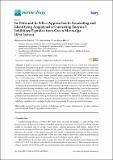Por favor, use este identificador para citar o enlazar a este item:
http://hdl.handle.net/10261/180709COMPARTIR / EXPORTAR:
 SHARE SHARE
 CORE
BASE CORE
BASE
|
|
| Visualizar otros formatos: MARC | Dublin Core | RDF | ORE | MODS | METS | DIDL | DATACITE | |

| Título: | In Vitro and In Silico Approaches to Generating and Identifying Angiotensin-Converting Enzyme I Inhibitory Peptides from Green Macroalga Ulva lactuca |
Autor: | Garcia-Vaquero, Marco; Mora, Leticia CSIC ORCID; Hayes, Maria | Palabras clave: | Seaweed protein Protein hydrolysate ACE-I Renin Allergenicity In silico analysis Functional food Bioactive peptides Bioinformatics |
Fecha de publicación: | 30-mar-2019 | Editor: | Multidisciplinary Digital Publishing Institute | Citación: | Marine Drugs 17(4): 204 (2019) | Resumen: | A protein extract was generated from the macroalga <i>Ulva lactuca</i>, which was subsequently hydrolysed using the food-grade enzyme papain and angiotensin-converting Enzyme I and renin inhibitory peptides identified using a combination of enrichment strategies employing molecular weight cutoff filtration and mass spectrometry analysis. The generated hydrolysates with the most promising in vitro activity were further purified using preparative RP-HPLC and characterised. The 1 kDa hydrolysate (1 kDa-UFH), purified and collected by preparative RP-HPLC at minutes 41‒44 (Fr41‒44), displayed statistically higher ACE-I inhibitory activities ranging from 96.91% to 98.06%. A total of 48 novel peptides were identified from these four fractions by LC-MS/MS. A simulated gastrointestinal digestion of the identified peptide sequences was carried out using in silico enzyme cleavage simulation tools, resulting in 86 peptide sequences that were further assessed for their potential activity, toxicity and allergenicity using multiple predictive approaches. All the peptides obtained in this study were predicted to be non-toxic. However, 28 out of the 86 novel peptides released after the in silico gastrointestinal digestion were identified as potential allergens. The potential allergenicity of these peptides should be further explored to comply with the current labelling regulations in formulated food products containing <i>U. lactuca</i> protein hydrolysates. | Versión del editor: | http://dx.doi.org/10.3390/md17040204 | URI: | http://hdl.handle.net/10261/180709 | DOI: | 10.3390/md17040204 | ISSN: | 1660-3397 |
| Aparece en las colecciones: | (IATA) Artículos |
Ficheros en este ítem:
| Fichero | Descripción | Tamaño | Formato | |
|---|---|---|---|---|
| marinedrugs-17-00204.pdf | 1,66 MB | Adobe PDF |  Visualizar/Abrir |
CORE Recommender
PubMed Central
Citations
19
checked on 03-may-2024
SCOPUSTM
Citations
54
checked on 09-may-2024
WEB OF SCIENCETM
Citations
38
checked on 27-feb-2024
Page view(s)
191
checked on 10-may-2024
Download(s)
279
checked on 10-may-2024

